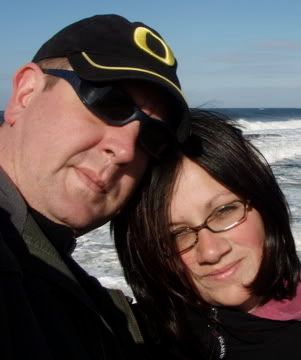Another famous sculpture called "El Entrevero" by Jose Belloni graces the fountain in Plaza Fabini along Montevideo's main boulevard, 18 de Julio. We went for a stroll through downtown toward the old city to stumble across more of the hidden historical gems of the city we would soon be leaving...

In the right rear of this picture is the building that houses the Museo Gaucho and Museo Moneda--two museums for the price of one, so we trotted over there for a look. (jeje, puns--and that's how they spell 'hehe' down here!)

A closer look at the building...

An older look...

An even older look...

The ornate entrance, decked in onyx, oak and granite is just the beginning. Ascending into the interior is like stepping onto an Escher canvas, with banisters and stairs winding and combining into an optical illusion of elegance...

The uppermost floors are dedicated to the history of the gauchos, filled with every ornate buckle or saddle or knife or mate cup you can imagine. The primary floor holds a combination of paintings and a smaller museum that details the history of money throughout civilization, from ancient Roman coinage to today's Uruguayan currency. Meanwhile, the wonderful architecture is omnipresent, from the tiled floors to molded windows...



We recently learned that mate, the national beverage, was not nearly as popular as it is now--everyone in the city enjoys walking and talking with their thermos and yerba in hand. But, in the past, only the gauchos imbibed regularly...

The horses were decorated with as much pride as their masters...

From stirrups...

To spurs...

To bolas...

To daggers...

To drinking horns...

To metallic mate cups...

Downstairs, in the Museo Moneda, an antique balances its in equilibrium, much like the symbolic one on the Uruguay coat of arms...

Modern notes...

Ancient coins...

And commemorative brass plaques of Uruguay's first minted peso, with Artigas on one side, and the new coat of arms--including the scale for justice, the city's founding hill of Cerro, the horse for strength, and the bull for prosperity--on the other...
 In the right rear of this picture is the building that houses the Museo Gaucho and Museo Moneda--two museums for the price of one, so we trotted over there for a look. (jeje, puns--and that's how they spell 'hehe' down here!)
In the right rear of this picture is the building that houses the Museo Gaucho and Museo Moneda--two museums for the price of one, so we trotted over there for a look. (jeje, puns--and that's how they spell 'hehe' down here!) A closer look at the building...
A closer look at the building... An older look...
An older look... An even older look...
An even older look... The ornate entrance, decked in onyx, oak and granite is just the beginning. Ascending into the interior is like stepping onto an Escher canvas, with banisters and stairs winding and combining into an optical illusion of elegance...
The ornate entrance, decked in onyx, oak and granite is just the beginning. Ascending into the interior is like stepping onto an Escher canvas, with banisters and stairs winding and combining into an optical illusion of elegance... The uppermost floors are dedicated to the history of the gauchos, filled with every ornate buckle or saddle or knife or mate cup you can imagine. The primary floor holds a combination of paintings and a smaller museum that details the history of money throughout civilization, from ancient Roman coinage to today's Uruguayan currency. Meanwhile, the wonderful architecture is omnipresent, from the tiled floors to molded windows...
The uppermost floors are dedicated to the history of the gauchos, filled with every ornate buckle or saddle or knife or mate cup you can imagine. The primary floor holds a combination of paintings and a smaller museum that details the history of money throughout civilization, from ancient Roman coinage to today's Uruguayan currency. Meanwhile, the wonderful architecture is omnipresent, from the tiled floors to molded windows...

 We recently learned that mate, the national beverage, was not nearly as popular as it is now--everyone in the city enjoys walking and talking with their thermos and yerba in hand. But, in the past, only the gauchos imbibed regularly...
We recently learned that mate, the national beverage, was not nearly as popular as it is now--everyone in the city enjoys walking and talking with their thermos and yerba in hand. But, in the past, only the gauchos imbibed regularly... The horses were decorated with as much pride as their masters...
The horses were decorated with as much pride as their masters... From stirrups...
From stirrups... To spurs...
To spurs... To bolas...
To bolas... To daggers...
To daggers... To drinking horns...
To drinking horns... To metallic mate cups...
To metallic mate cups... Downstairs, in the Museo Moneda, an antique balances its in equilibrium, much like the symbolic one on the Uruguay coat of arms...
Downstairs, in the Museo Moneda, an antique balances its in equilibrium, much like the symbolic one on the Uruguay coat of arms... Modern notes...
Modern notes... Ancient coins...
Ancient coins... And commemorative brass plaques of Uruguay's first minted peso, with Artigas on one side, and the new coat of arms--including the scale for justice, the city's founding hill of Cerro, the horse for strength, and the bull for prosperity--on the other...
And commemorative brass plaques of Uruguay's first minted peso, with Artigas on one side, and the new coat of arms--including the scale for justice, the city's founding hill of Cerro, the horse for strength, and the bull for prosperity--on the other...

No comments:
Post a Comment